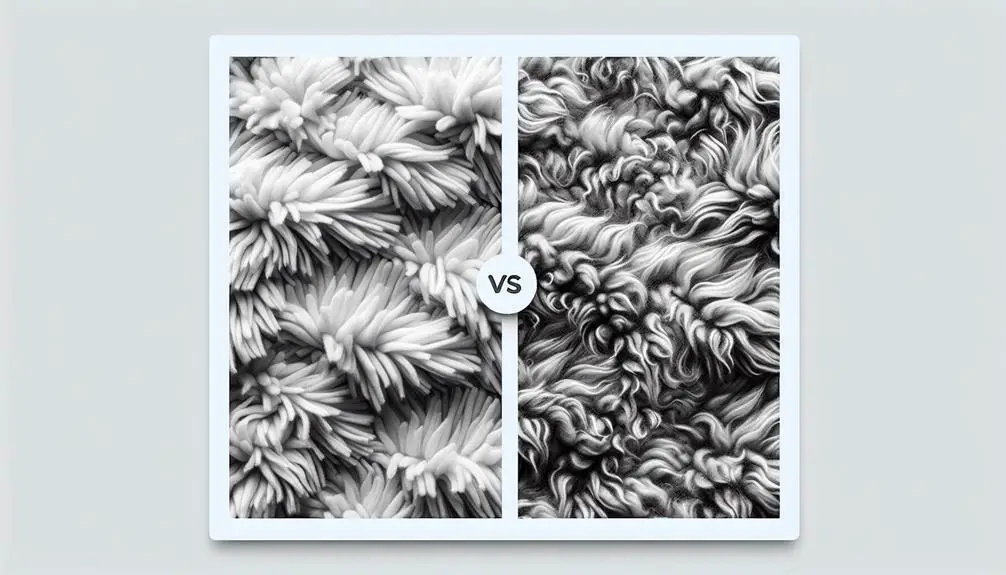You might think fleece and sherpa are just two different names for the same fabric, but there's a distinct contrast worth exploring.
While both fabrics offer warmth and comfort, their structures and qualities set them apart.
Unraveling the characteristics of fleece and sherpa could help you make an informed choice based on your preferences and needs.
Let's delve into the nuances of these materials to uncover which one might suit you best.
Table of Contents
Key Takeaways
- Sherpa offers superior warmth with dense pile construction.
- Premium sherpa is luxurious but more costly.
- Sherpa blankets excel in heat retention for colder climates.
- Sherpa fabric is thicker and softer, resembling natural sheepskin.
What Is Fleece Fabric?
Fleece fabric, created in 1979 by Malden Mills, is primarily made from polyester fibers. This synthetic material is well-known for its exceptional softness, providing a luxurious feel against the skin.
The polyester composition of fleece contributes to its warmth, making it a popular choice for various cold-weather clothing items. When compared to natural fibers like wool, polyester fleece retains its softness even after multiple washes, maintaining its comfort and durability over time.
This fabric's ability to trap heat efficiently while remaining lightweight adds to its appeal for those seeking warmth without bulkiness. The brushed texture of fleece creates a plush pile that enhances its insulating properties, ensuring a cozy experience for the wearer.
Types Of Fleece
I'll begin by outlining the various types of fleece materials available.
These include polar fleece, microfleece, and Lycra-Spandex fiber, each with its distinct characteristics.
These variations in fleece fabric offer specific properties that cater to different needs and preferences.
Understanding the differences among these fleece types will help in making informed decisions when choosing the right material for various applications.
Fleece Fabric Varieties
Exploring the diverse varieties of fleece fabric reveals distinct characteristics that cater to a range of needs and preferences.
- Polar Fleece: Known for its thickness and warmth, ideal for winter garments and blankets.
- Microfleece: A lightweight option providing insulation without bulk, suitable for layering in cold weather.
- Lycra-blend Fleece: Combines the stretchiness of Lycra with the warmth of fleece, offering comfort and flexibility in clothing.
- Various Needs: Different types of fleece fabrics cater to a wide range of requirements, from heavy-duty warmth to lightweight, breathable options.
Understanding the unique properties of polar fleece, microfleece, and Lycra-blend fleece enables one to select the most suitable fabric based on the intended purpose and desired comfort level.
Sherpa Material Characteristics
Sherpa material, known for its soft, brushed texture reminiscent of sheepskin, offers distinct characteristics compared to traditional fleece fabrics. Unlike fleece, which is typically a blend of polyester and other fibers, Sherpa fabric is primarily composed of 100% polyester. This composition contributes to Sherpa's heavier weight, making it ideal for colder climates.
The durability of Sherpa fabric surpasses that of fleece, as it's less prone to pilling. However, Sherpa is less water-resistant than fleece and tends to absorb more moisture. The brushed surface of Sherpa provides a cozy, insulating feel, while fleece has a smoother texture.
Both fabrics, being synthetic fibers, offer unique qualities suitable for various preferences and needs.
Comparison: Fleece Vs. Sherpa
Moving from the characteristics of Sherpa material, it's important to compare the types of fleece available to understand the differences between fleece and Sherpa.
- Fleece fabric is synthetic, usually made from polyester or a blend of polyester and other fibers.
- Sherpa fabric is usually plush and soft, mimicking the feel of sheepskin for added comfort.
- Fleece blankets are soft, lightweight, and provide warmth, but may vary in softness.
- Sherpa blankets, on the other hand, offer luxurious coziness, warmth, and breathability due to their multilayered design.
Understanding these distinctions can help in choosing the best option based on preference for warmth, comfort, and texture.
What Is Sherpa Fabric?
Sherpa fabric is a cozy and warm synthetic fleece made from 100% polyester, resembling the feel of sheepskin.
I'll discuss the characteristics, uses, and care tips for this popular material in the upcoming points.
Let's explore the world of Sherpa fabric together.
Sherpa Fabric Characteristics
Featuring a unique two-sided design, the Sherpa fabric combines a smooth knit with a soft, silky pile, offering both comfort and warmth.
- Made primarily of 100% synthetic polyester, Sherpa fabric mimics the qualities of sheepskin.
- Known for its warmth, softness, and moisture-wicking properties, Sherpa fabric provides a cozy experience.
- The fabric's name 'Sherpa' is a nod to the resilient Sherpa people of Nepal who endure harsh conditions.
- Commonly used in blankets, clothing linings, and other products, Sherpa fabric's plushness adds a touch of luxury and comfort to various items.
Uses of Sherpa Material
Having explored the characteristics of Sherpa fabric, it's fascinating to see the varied applications of this versatile material in different products. Sherpa fabric, known for its warmth and softness, is commonly used in blankets, throws, outerwear, and pet beds due to its comfort and insulation properties. Below is a table showcasing the diverse uses of Sherpa material:
| Product | Description | Benefits |
|---|---|---|
| Blankets | Cozy and warm blankets for cold nights | Provides exceptional warmth |
| Throws | Stylish throws for decorative purposes | Adds a touch of elegance to any room |
| Outerwear | Jackets and coats for chilly weather | Insulates effectively against the cold |
| Pet Beds | Comfortable beds for pets | Offers a soft and cozy resting place |
Care Tips for Sherpa
Taking care of Sherpa fabric involves following specific guidelines to guarantee its longevity and softness.
- Wash in cold water: Use a gentle cycle with cold water to prevent damage to the synthetic polyester fibers.
- Avoid high heat: Refrain from exposing Sherpa fabric to high temperatures as it can lead to melting or deformation.
- Air-dry or tumble dry on low heat: To maintain the plush texture, air-dry or use a low heat setting when tumble drying.
- Brush or shake regularly: Preserve the fluffiness of Sherpa blankets by gently brushing or shaking them out to prevent matting of the fibers.
What Does Sherpa Fleece Consist Of?
Sherpa fleece comprises 100% synthetic polyester fibers, mimicking the warmth and softness of sheepskin. These synthetic fibers are adept at retaining heat, making Sherpa fleece an excellent choice for cold weather. The softness of Sherpa fleece against the skin provides a luxurious feel, akin to the comfort of natural sheepskin. Additionally, the moisture-wicking properties of Sherpa fleece help regulate body temperature by drawing sweat away from the skin, keeping you dry and cozy.
The use of synthetic polyester fibers in Sherpa fleece not only replicates the desirable qualities of sheepskin but also offers a more economical and sustainable alternative. This composition makes Sherpa fleece a popular option for individuals seeking warmth, comfort, and durability without compromising on quality. Whether used in blankets, clothing, or accessories, Sherpa fleece continues to be a favored choice for those looking for a reliable and affordable option for staying snug during chilly seasons.
Differences Between Microfleece And Premium Sherpa
When comparing microfleece to premium sherpa, one can easily distinguish their key characteristics based on thickness and texture.
- Premium sherpa is a thicker, plush fleece with a luxurious feel, while microfleece is a lightweight, thin fleece fabric.
- Premium sherpa offers superior warmth and insulation due to its dense pile and multi-layered construction, whereas microfleece is known for its softness and moisture-wicking properties.
- Premium sherpa provides a cozy and velvety texture, making it perfect for high-end blankets and outerwear, while microfleece is popular for lightweight garments and athletic wear.
- The cost of premium sherpa is typically higher than microfleece because of its premium quality, warmth, and luxurious feel.
These differences between microfleece and premium sherpa make them unique in their own right, catering to different needs and preferences, especially when it comes to Sherpa blankets and fleece fabrics that are brushed.
Which Fabric Is Warmer
Comparing the warmth levels of fleece and sherpa fabrics reveals a clear distinction in their heat-retaining capabilities. Sherpa fabric, with its dense pile and plush texture, is inherently warmer than fleece. The thick, multilayered design of sherpa traps heat effectively, mimicking the warmth of sheepskin and making it an ideal choice for colder temperatures.
In contrast, fleece blankets offer warmth as well, but their insulation can vary depending on their thickness. While fleece comes in different thickness levels, affecting its warmth retention, sherpa's structure guarantees maximum heat retention and insulation. When prioritizing warmth, sherpa blankets tend to be favored for their superior heat-retaining properties over traditional fleece options.
If ultimate warmth and coziness are your top priorities, opting for a sherpa blanket would be the ideal choice due to its superior insulation capabilities compared to fleece.
Should I Choose A Fleece Blanket Or A Sherpa Blanket?
Considering factors such as weight, warmth, durability, and moisture-wicking capabilities, deciding between a fleece blanket and a sherpa blanket hinges on personal preferences and specific needs.
- Weight: Fleece blankets are generally lighter, offering a cozy feel without being too heavy, while Sherpa blankets provide a more substantial, warmer option.
- Warmth: Sherpa blankets excel in providing maximum warmth due to their plush, fuzzy pile, ideal for colder climates or individuals seeking extra coziness.
- Durability: Sherpa blankets are typically more durable and less prone to pilling compared to fleece blankets, ensuring long-lasting comfort and quality.
- Moisture-Wicking: Fleece blankets are more water-resistant, making them suitable for various settings where moisture might be a concern, whereas Sherpa blankets, although absorbing more moisture, offer superior warmth retention.
Ultimately, your choice between a fleece or sherpa blanket should align with your priorities regarding fabric feel, warmth requirements, durability expectations, and moisture-wicking needs.
What Fabric Is Softer
Sherpa fabric stands out as particularly softer than fleece, attributed to its plush, silky pile texture. The smooth knit on one side of Sherpa fabric enhances its luxurious softness, providing a cozy feel reminiscent of sheepskin.
While fleece is generally soft, it can vary in texture, with some types feeling scratchy compared to the consistent softness of Sherpa. Sherpa fabric is designed to mimic the comfort and warmth of natural sheepskin, making it an excellent choice for blankets and clothing items where a soft touch is desired.
What Fabric Is Thicker
Sherpa fabric's thickness sets it apart from most fleece varieties, providing a more substantial feel that enhances its cozy appeal. When comparing the thickness of sherpa fabric to fleece blankets, the following points become evident:
- Sherpa fabric is generally thicker than most fleece fabrics, offering a plush and thicker appearance due to its pile design.
- Fleece blankets can vary in thickness; for instance, polar fleece tends to be thicker than microfleece options.
- The thickness of sherpa fabric falls between sheepskin and thin cotton fabrics, striking a balance between warmth and bulkiness.
- When seeking a thicker fabric choice for added warmth and comfort, sherpa is often preferred over standard fleece due to its substantial feel.
Frequently Asked Questions
Which Is Better Fleece or Sherpa?
I prefer Sherpa for its exceptional warmth and softness. It provides a cozy and plush feel that's perfect for colder weather. Fleece offers various thickness options for different warmth levels, making it versatile for various needs.
Is Sherpa Fleece the Warmest?
Yes, Sherpa fleece is considered one of the warmest materials available. Its dense structure effectively traps heat, providing exceptional insulation. The smooth knit on one side and fuzzy pile on the other enhance warmth, making it ideal for cold weather.
What Does Sherpa Feel Like?
Sherpa feels incredibly soft and plush, almost like being wrapped in a cloud. Its cozy texture provides a warm and comforting sensation against the skin, making it perfect for chilly days. It's like a gentle hug.
Is Sherpa or Fleece Better for Photo Blanket?
For a photo blanket, Sherpa adds luxurious texture and warmth to images, while fleece offers a lighter and versatile option. The choice depends on the desired aesthetic and warmth level. Sherpa's plushness enhances visual appeal, creating a cozy look.
- What Is the Best Thread Count for Percale Sheets? - July 14, 2025
- What Are Peached Percale Sheets? The Ultimate Guide to Softness - July 14, 2025
- Are Percale Sheets Softer Than Other Materials? A Comparison - July 14, 2025






